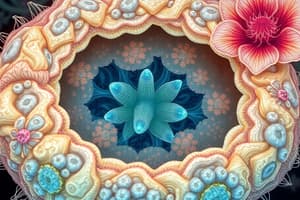Podcast
Questions and Answers
Which of these cell components are found in both animal and plant cells?
Which of these cell components are found in both animal and plant cells?
- Nucleus, cytoplasm, vacuole, and mitochondria
- Nucleus, cell membrane, cytoplasm, and mitochondria (correct)
- Nucleus, cell membrane, cytoplasm, and cell wall
- Cell membrane, cytoplasm, cell wall, and vacuole
What is the function of the cell membrane in an animal cell?
What is the function of the cell membrane in an animal cell?
- Releases energy from glucose
- Provides structural support and shape
- Stores genetic information
- Controls the movement of substances into and out of the cell (correct)
Which of these organisms is an example of a multicellular organism?
Which of these organisms is an example of a multicellular organism?
- Bacteria
- Amoeba
- Blue Whale (correct)
- Yeast
What is the function of the mitochondria in a plant cell?
What is the function of the mitochondria in a plant cell?
Which of the following is NOT a key component of an animal cell?
Which of the following is NOT a key component of an animal cell?
What is the main reason why many cells are too small to be seen with the naked eye?
What is the main reason why many cells are too small to be seen with the naked eye?
Which of these statements BEST describes the relationship between cells and organisms?
Which of these statements BEST describes the relationship between cells and organisms?
Which of these is an example of a specialized cell?
Which of these is an example of a specialized cell?
Flashcards
Cell
Cell
The smallest unit of life, the building block of all organisms.
Animal Cell
Animal Cell
A type of cell that often has an irregular shape and contains a nucleus, cytoplasm, cell membrane, and mitochondria.
Plant Cell
Plant Cell
A type of cell with a regular shape, containing a nucleus, cell membrane, cytoplasm, mitochondria, cell wall, and vacuole.
Nucleus
Nucleus
Signup and view all the flashcards
Cytoplasm
Cytoplasm
Signup and view all the flashcards
Cell Membrane
Cell Membrane
Signup and view all the flashcards
Mitochondria
Mitochondria
Signup and view all the flashcards
Specialized Cells
Specialized Cells
Signup and view all the flashcards
Study Notes
Cells: The Building Blocks of Life
- Cells are the fundamental units of all living organisms.
- Cells are incredibly small, often needing a microscope to be seen.
- Some organisms, like bacteria, are unicellular (composed of a single cell), while others like trees and whales are multicellular (composed of many cells).
- Multicellular organisms often have specialized cells with specific functions.
Animal Cell Structure
- Animal cells typically have an irregular shape.
- Key components include:
- Nucleus: Contains the genetic material (DNA), controlling cell activities.
- Cytoplasm: The fluid filling most of the cell, where chemical reactions occur.
- Cell membrane: The flexible outer layer regulating substance passage in and out of the cell.
- Mitochondria: Tiny structures within the cytoplasm, where energy is released from food (glucose) through respiration.
Plant Cell Structure
- Plant cells usually have a regular shape.
- Plant cells share the same components as animal cells (nucleus, cytoplasm, cell membrane, mitochondria).
- Plant cells possess three additional structures:
- Cell wall: A tough outer layer made of cellulose, providing strength and support.
- Vacuole: A space containing cell sap, maintaining cell firmness.
- Chloroplasts: Structures containing chlorophyll (the green pigment) where photosynthesis takes place – found only in plant cells in green parts.
Cell Types and Activities
- Onion cells: A type of cell available for study.
- Magnification activity: Allows observation of cell detail through various microscope magnifications.
- Atomic labs: A digital activity for learning about cell structure.
Studying That Suits You
Use AI to generate personalized quizzes and flashcards to suit your learning preferences.




